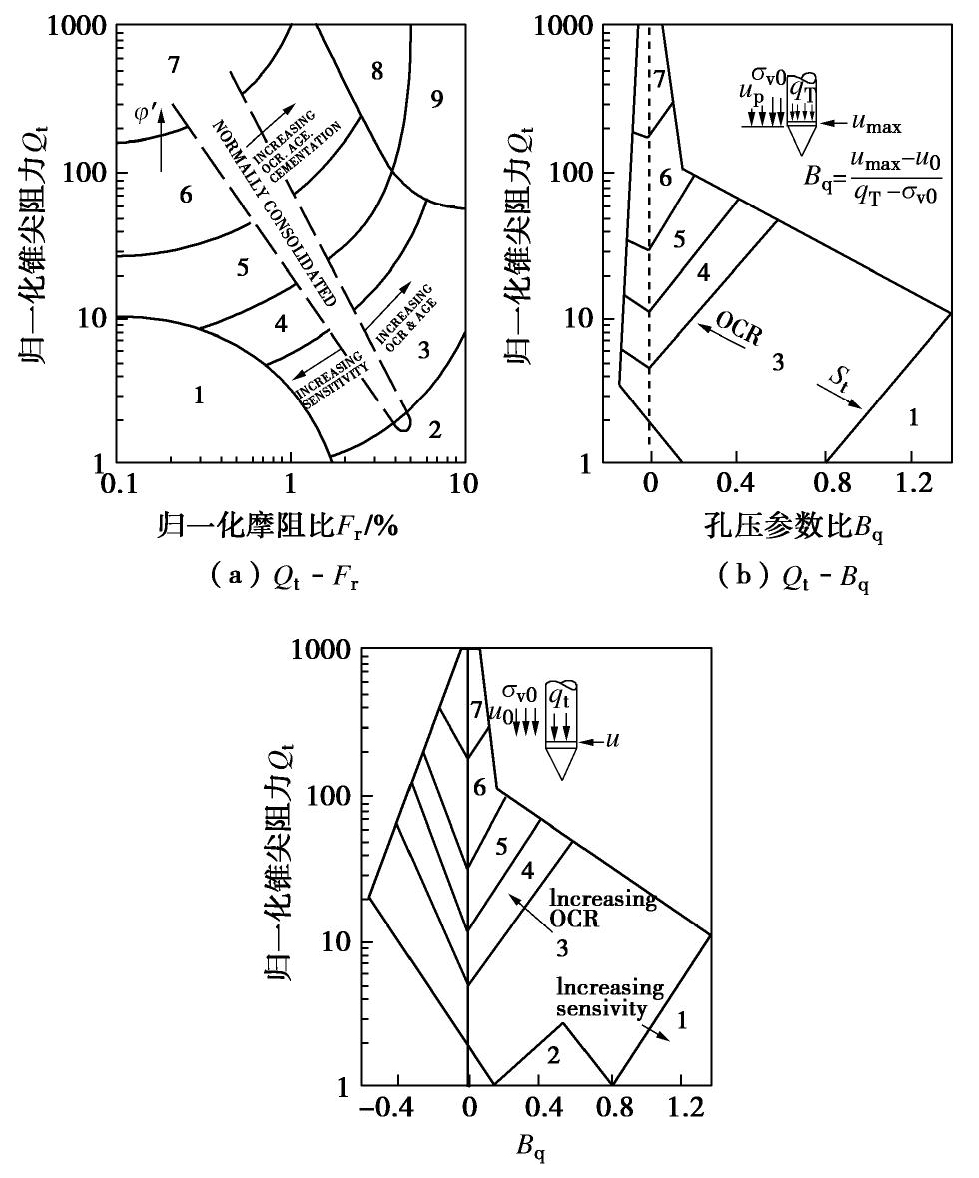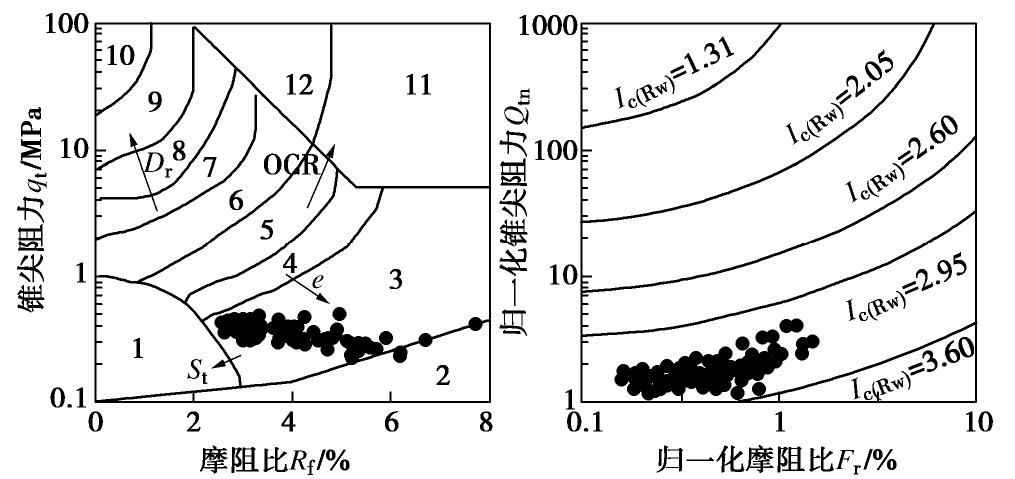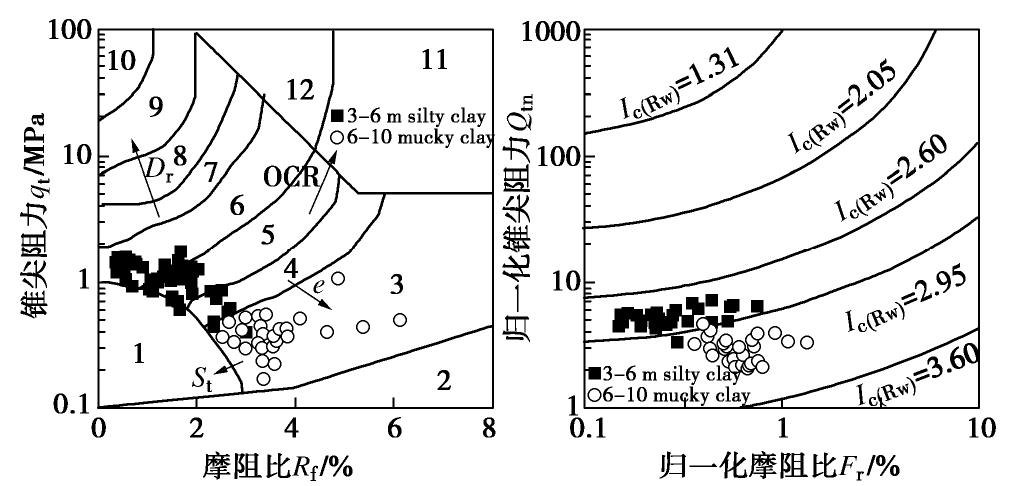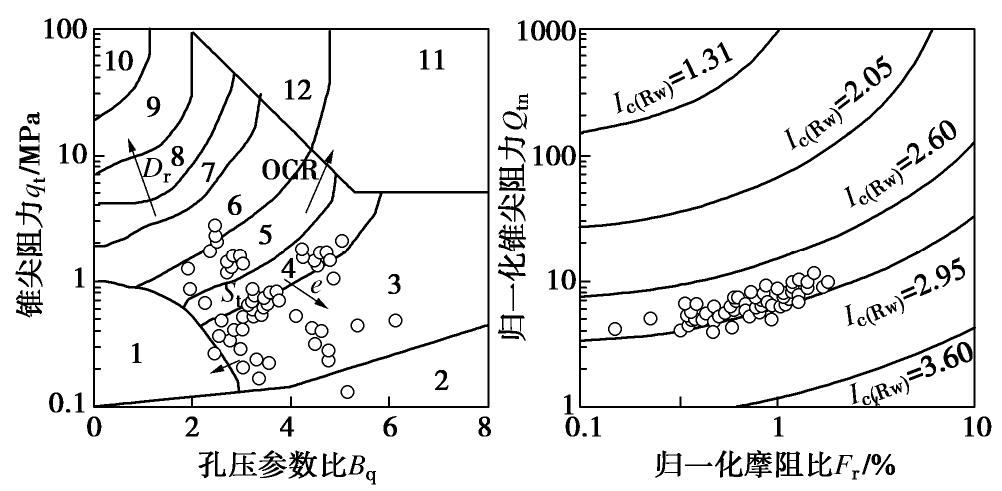Classification of soft clay in Jiangsu Province based on piezocone penetration tests
-
摘要: 基于江苏地区典型软土的孔压静力触探(CPTU)测试数据,对江苏地区软土分类进行研究。分析对比国际上常用的CPTU土分类方法,分别采用SBT(soil behavior type)分类方法和Ic(土类指数)分类方法,对江苏地区的苏北滨海相,里下河泻湖相,长江三角洲冲积相和太湖冲湖积相等软土进行土分类。分类结果表明,CPTU原位测试可以有效识别江苏地区典型软土进行土分类,SBT土分类结果与Ic土分类结果具有良好的一致性,Ic土分类图中不同土类之间的分界线更为明显。Abstract: The classification results of soft soils in Jiangsu Province are derived through the CPTU data. The soil classification methods based on the CPTU data are reiviewed, then the SBT (soil behavior type) method and the Ic (soil index) method are chosen to identify the soft soils in Jiangsu province, including Northern Jiangsu marine clay, Lixiahe lagoon clay, Yangtze Delta alluvial clay and Taihu alluvial clay. The soil classification results show that the CPTU data can be used to effectively recognize the typical soft soils in Jiangsu province, and the SBT results are consistent with Ic results. Morever, the boundary between different soil types is more obvious in Ic soil classification chart.
-
-
表 1 江苏区域典型软土的Ic值
Table 1 Typical values of Ic of soft soils in Jiangsu province
软土区域 Ic值范围 苏北滨海相软土 3.12< Ic <3.42 里下河泻湖相软土 2.92< Ic<3.32 长江三角洲冲积相软土 2.84< Ic<3.12 太湖冲湖积相软土 2.74< Ic <2.98 -
[1] 邓永锋, 吴燕开, 刘松玉, 等. 连云港浅层海相软土沉积环境及物理力学性质研究[J]. 工程地质学报, 2005, 13(1): 29-33. https://www.cnki.com.cn/Article/CJFDTOTAL-GCDZ200501003.htm DENG Yong-feng, WU Yan-kai, LIU Song-yu, et al. Sediment environment of shallow marine clays deposited in Lianyungang area and their physical and mechanical properties[J]. Journal of Engineering Geology, 2005, 13(1): 29-33. (in Chinese) https://www.cnki.com.cn/Article/CJFDTOTAL-GCDZ200501003.htm
[2] 刘松玉, 蔡国军, 邹海峰. 基于CPTU的中国实用土分类方法研究[J]. 岩土工程学报, 2013, 35(10): 1765-1776. https://www.cnki.com.cn/Article/CJFDTOTAL-YTGC201310002.htm LIU Song-yu, CAI Guo-jun, ZOU Hai-feng. Practical soil classification methods in China based on piezocone penetration tests[J]. Chinese Journal of Geotechnical Engineering, 2013, 35(10): 1765-1776. (in Chinese) https://www.cnki.com.cn/Article/CJFDTOTAL-YTGC201310002.htm
[3] 岩土工程勘察规范:GB50021—2001[S]. 2009. Code for Investigation of Geotechnical Engineering: GB 50021—2001[S]. 2009. (in Chinese)
[4] ASTM. Standard practice for classification of soils for engineering purpose (USCS)[S]. ASTM Standard D2487. ASTM International, West Conshohocken, PA.
[5] JONES G A, RUST E. Piezometer penetration testing CPTU[C]//Proceedings of the 2nd European Symposium on Penetration Testing, ESOPT-II. Amsterdam, 1982.
[6] SENNESET K, JANBU N. Shear strength parameters obtained from static cone penetration tests[C]//Proceedings of Strength Testing of Marine sediments; Laboratory and In situ Measurement. San Diego, 1985
[7] ROBERTSON P K, CAMPANELLA R G, GILLESPIE D, et al. Use of piezometer cone data[C]//Proceedings of the ASCE Specialty Conference In Situ'86Blacksburg, 1986.
[8] WROTH C P. The interpretation of in situ soil tests[J]. Géotechnique, 1984, 34(4): 449-489. doi: 10.1680/geot.1984.34.4.449
[9] WROTH C P. Penetration testing: a more rigorous approach to interpretation[C]//Proceedings of the International Symposium on Penetration Testing, ISOPT-1. Orlando, 1988.
[10] ROBERTSON P K. Soil classification using the cone penetration test[J]. Canadian Geotechnical Journal, 1990, 27(1): 151-158. doi: 10.1139/t90-014
[11] LUNNE T, POWELL J J M, ROBERTSON P K. Cone penetration testing in geotechnical practice[M]. London: Blackie Academic and Professional, 1997.
[12] JEFFERIES M G, DAVIES M P. Soil classification by the cone penetration test: Discussion[J]. Canadian Geotechnical Journal, 1991, 28(1): 173-176. doi: 10.1139/t91-023
[13] PINCUS H J, JEFFERIES M G, DAVIES M P. Use of CPTu to estimate equivalent SPT N60[J]. Geotechnical Testing Journal, 1993, 16(4): 458. doi: 10.1520/GTJ10286J
[14] BEEN K, JEFFERIES M G. Towards Systematic CPT Interpretation[C]//Proceedings of Wroth Memorial Symposium, Telford Thomas, London, 1992.
[15] ROBERTSON P K, WRIDE C F. Evaluating cyclic liquefaction potential using the cone penetration test[J]. Canadian Geotechnical Journal, 1998, 35(3): 442-459. doi: 10.1139/t98-017
[16] ZHANG G, ROBERTSON P K, BRACHMAN R W I. Estimating liquefaction-induced ground settlements from CPT for level ground[J]. Canadian Geotechnical Journal, 2002, 39(5): 1168-1180. doi: 10.1139/t02-047
[17] ROBERTSON P K. Interpretation of cone penetration tests—a unified approach[J]. Canadian Geotechnical Journal, 2009, 46(11): 1337-1355. doi: 10.1139/T09-065
-
期刊类型引用(15)
1. 加瑞,赵栋,雷华阳,杨岗. 胶结砂土的静力触探模型试验及离散元模拟. 工程地质学报. 2025(02): 722-732 .  百度学术
百度学术
2. 霍泽辉,陈丰,张松,孙川川. 天津地区深部土层的静力触探指标与物理力学指标相关性研究. 矿产勘查. 2025(03): 641-650 .  百度学术
百度学术
3. 杨东东. 基于孔压静力触探的土层分类研究. 中国新技术新产品. 2024(04): 102-104 .  百度学术
百度学术
4. 马昌慧,陈义平,郭峰,李栋广. 浅析基坑工程的优化设计方法. 工程勘察. 2024(04): 26-30 .  百度学术
百度学术
5. 魏军. 大型自升式海工平台桩靴地基土工程特性试验研究. 江苏建筑. 2024(02): 96-100+120 .  百度学术
百度学术
6. 李伟. 软基处理PST桩复合地基加固机理及CPTU验证. 山西建筑. 2024(11): 76-80+85 .  百度学术
百度学术
7. 时文峰,丁川,仇涛,童立元,王逸凡,马海洋. 地下工程预制梁钢筋骨架安装与成型技术研究. 建筑技术. 2024(16): 1924-1928 .  百度学术
百度学术
8. 肖乾,袁颖,汪婷. 基于系统聚类算法的CPT土体分层试验研究. 湖北理工学院学报. 2024(06): 36-41 .  百度学术
百度学术
9. 卢云龙,戴正彬,汤国毅. 基于静力触探对深基坑突涌区地层扰动的分析. 土工基础. 2023(01): 157-160 .  百度学术
百度学术
10. 丁剑桥. 基于静力触探的桩基承载力及数值模拟分析. 安徽建筑. 2023(03): 135-136+173 .  百度学术
百度学术
11. 吴早生,胡春东,白浩东,沙鹏,黄曼,王天佐. 静力触探深度与垂直度实时智能监测系统的应用研究. 中国新技术新产品. 2023(04): 90-93 .  百度学术
百度学术
12. 曹振平,曾彪,张雨波,孟韬,周盛生,谷军. 基于CPTU的长江河漫滩相软土夹层分布特征与渗透特性评价. 勘察科学技术. 2023(03): 43-48+64 .  百度学术
百度学术
13. 吴早生,白浩东,胡春东,沙鹏,黄曼,张鑫,王天佐. 基于静力触探数据的绍兴平原地区土层参数分析评价. 岩土工程技术. 2023(06): 692-699 .  百度学术
百度学术
14. 郭全元,钟仕兴,肖旺. 基于孔压静力触探(CPTU)及扁铲侧胀试验(DMT)南沙软土力学特性研究. 广东土木与建筑. 2022(06): 26-29 .  百度学术
百度学术
15. 周燕国,王智男,马强,梁甜,陈云敏. ZJU-400离心机机载微型CPTu装置研制与性能测试. 岩土工程学报. 2022(S2): 11-15 .  本站查看
本站查看
其他类型引用(5)



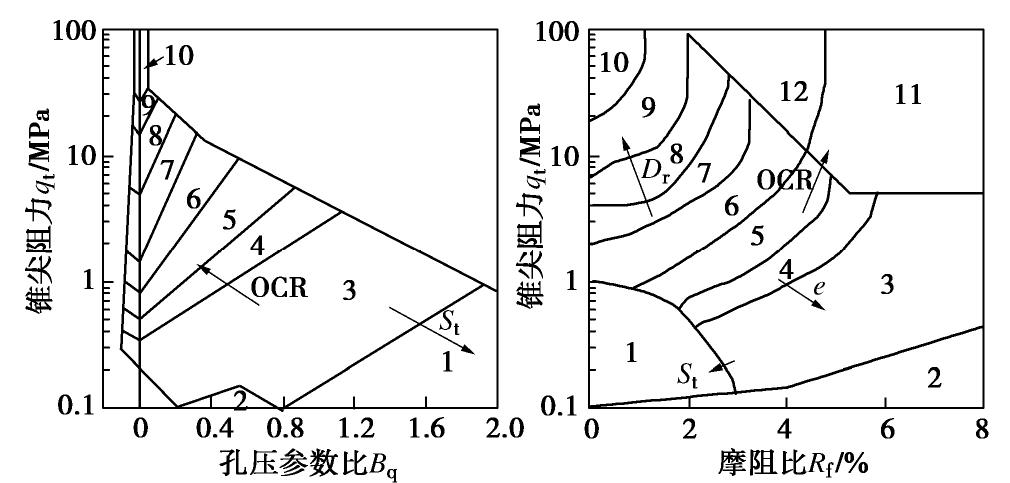
 下载:
下载:
